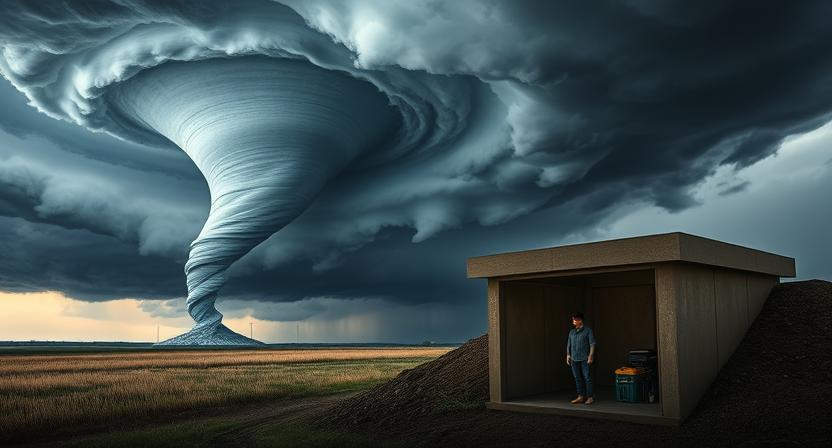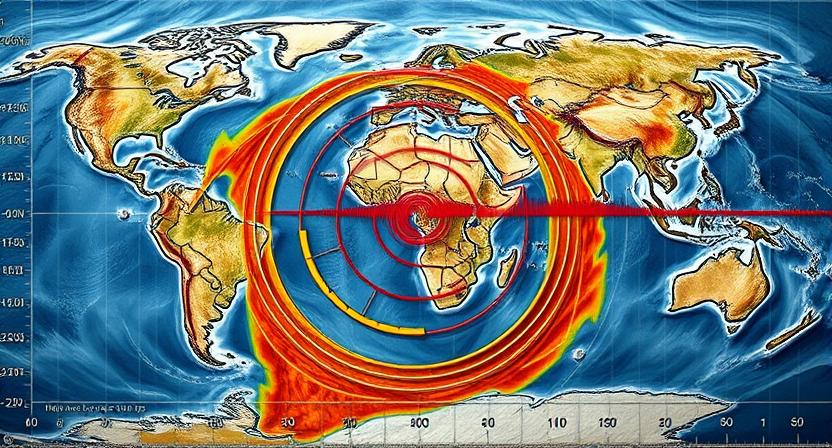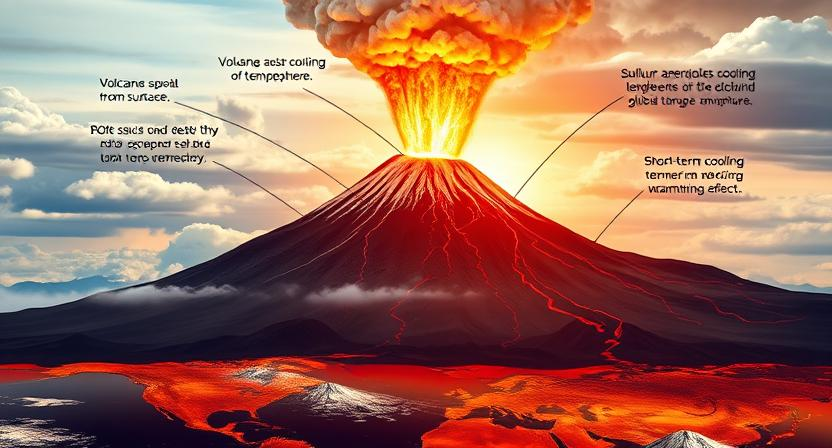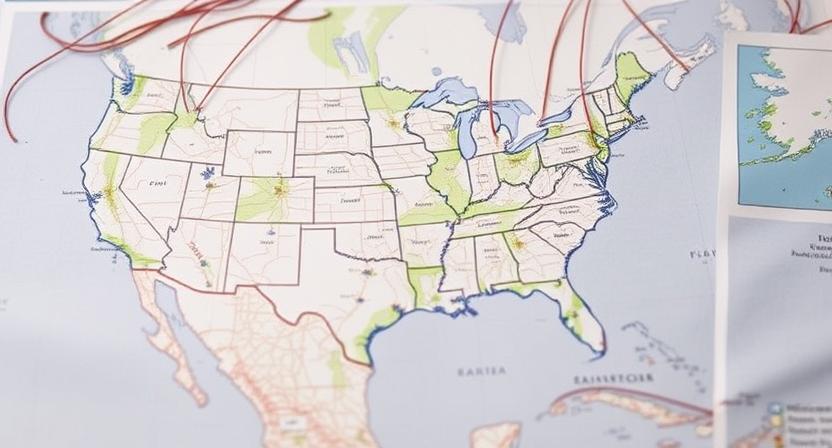
Formation of Supercell Thunderstorms

Supercell thunderstorms are powerful, rotating thunderstorms that can produce severe weather outcomes such as large hail, damaging winds, and tornadoes. These intense storms typically form in environments where there is a significant amount of wind shear, creating a rotating updraft that distinguishes them from other types of thunderstorms. The presence of a strong updraft, combined with favorable atmospheric conditions, allows these storms to persist and intensify, making them more potent and long-lasting compared to other types of thunderstorms.
The formation of supercell thunderstorms is often influenced by the collision of different air masses, such as warm, moist air from the south meeting cooler, drier air from the north. This clash of air masses sets the stage for the development of the rotating updraft that characterizes supercells. As these storms continue to mature, the presence of wind shear and lifting mechanisms further enhance the rotation within the storm, increasing the likelihood of severe weather events. Understanding the formation of supercell thunderstorms is crucial in predicting and preparing for the potential hazards they may bring.
• Supercell thunderstorms are powerful, rotating storms that can produce severe weather outcomes
• They typically form in environments with significant wind shear
• The presence of a strong updraft and favorable atmospheric conditions allow these storms to persist and intensify
• Collision of different air masses, such as warm, moist air from the south meeting cooler, drier air from the north, influences supercell formation
• Wind shear and lifting mechanisms further enhance rotation within the storm as it matures
Colliding Air Masses
When different air masses with contrasting temperature, humidity, and density come into contact, it sets the stage for atmospheric instability. This collision often occurs along boundaries such as cold fronts, warm fronts, or drylines, where warm, moist air clashes with cooler, drier air. The interaction between these air masses can lead to rapid uplift of air parcels, triggering the formation of thunderstorms and potentially severe weather.
The clash of these air masses can result in the rapid ascent of warm, moist air over cooler, denser air, creating an unstable atmosphere ripe for thunderstorm development. As the warm air rises, it cools and condenses, releasing latent heat and energy that fuel the intensification of thunderstorms. Colliding air masses can also enhance wind shear, a crucial ingredient for supercell thunderstorms and tornado formation. In regions prone to severe weather, such as Tornado Alley in the United States, the collision of air masses can significantly contribute to the frequency and intensity of tornado outbreaks.
• When different air masses with contrasting temperature, humidity, and density come into contact, it sets the stage for atmospheric instability.
• This collision often occurs along boundaries such as cold fronts, warm fronts, or drylines.
• The clash of these air masses can result in the rapid ascent of warm, moist air over cooler, denser air.
• Colliding air masses can lead to the formation of thunderstorms and potentially severe weather.
• As the warm air rises, it cools and condenses, releasing latent heat and energy that fuel the intensification of thunderstorms.
Wind Shear
Wind shear refers to the change in wind speed and direction with altitude. This atmospheric phenomenon can be crucial in the development and strength of severe thunderstorms and tornadoes. When wind shear is present, it can contribute to the rotation of a storm, leading to the formation of a supercell thunderstorm.
In the context of tornado formation, wind shear plays a significant role in tilting and stretching the rotating updraft within a storm. This tilting motion can enhance the organization of the storm, increasing the likelihood of a tornado touching down. Wind shear is one of the key factors that meteorologists monitor to assess the potential for severe weather outbreaks and issue timely warnings to keep communities safe.
• Wind shear refers to the change in wind speed and direction with altitude
• It can be crucial in the development and strength of severe thunderstorms and tornadoes
• Wind shear can contribute to the rotation of a storm, leading to the formation of a supercell thunderstorm
• In tornado formation, wind shear tilts and stretches the rotating updraft within a storm
• This tilting motion enhances storm organization, increasing the likelihood of a tornado touching down
• Meteorologists monitor wind shear to assess potential for severe weather outbreaks and issue timely warnings
Lifting Mechanisms
Air parcels need a mechanism to rise in order to form severe storms like supercell thunderstorms. Lifting mechanisms are essential in initiating the upward movement of warm, moist air, which can lead to the development of powerful thunderstorms. Several factors can act as lifting mechanisms, such as fronts, mountains, or even outflow boundaries from previous storms.
The collision of different air masses can create a lifting mechanism by forcing warmer air to rise over cooler, denser air. When warm air is forced to ascend, it cools and condenses, leading to the formation of towering cumulonimbus clouds that can develop into supercell thunderstorms. Wind shear, another lifting mechanism, plays a crucial role in creating an environment conducive to severe weather by causing horizontal spinning of the air and enhancing storm rotation.
• Fronts, mountains, or outflow boundaries can act as lifting mechanisms
• Collision of different air masses forces warmer air to rise over cooler, denser air
• Wind shear plays a crucial role in creating an environment conducive to severe weather
Tornado Alley
Tornado Alley, a region in the central United States known for its high frequency of tornadoes, encompasses parts of Texas, Oklahoma, Kansas, and Nebraska. This area experiences a unique convergence of colliding air masses, which creates an environment conducive to the formation of supercell thunderstorms. These powerful storms often generate the intense wind shear needed for tornadoes to develop, making Tornado Alley a hotspot for severe weather events during the spring and early summer months.
The prevalence of tornadoes in Tornado Alley can be attributed to the region’s geographic and meteorological characteristics. The flat terrain and clash of warm, moist air from the Gulf of Mexico with cool, dry air from the Rocky Mountains provide the ideal conditions for severe thunderstorm development. Additionally, the lifting mechanisms present in this area, such as drylines and cold fronts, further contribute to the likelihood of tornado formation, earning Tornado Alley its reputation as a prime tornado hotspot in the United States.
• Tornado Alley is located in the central United States
• Encompasses parts of Texas, Oklahoma, Kansas, and Nebraska
• Unique convergence of colliding air masses creates ideal conditions for tornado formation
• Supercell thunderstorms with intense wind shear are common in this region
The geographic and meteorological characteristics of Tornado Alley play a significant role in the high frequency of tornadoes experienced in this area. The flat terrain, clash of warm and cool air masses, and presence of lifting mechanisms all contribute to the perfect storm for severe weather events. As a result, residents living in Tornado Alley must remain vigilant during the spring and early summer months when tornado activity is at its peak.
Enhanced Fujita Scale

The Enhanced Fujita Scale, commonly referred to as the EF Scale, was introduced in 2007 to provide a more precise and detailed classification system for tornado intensity. This scale replaced the original Fujita Scale and takes into account not only wind speeds but also the degree of damage caused by the tornado. With its enhanced criteria for categorizing tornadoes based on the damage they produce, the EF Scale has improved the accuracy of assessing tornado strength and severity.
The EF Scale ranges from EF0 to EF5, with EF0 being the weakest and EF5 being the most destructive. Each category is determined by the estimated wind speeds and the type of damage inflicted on structures such as trees, buildings, and vehicles. By incorporating a broader range of damage indicators, the Enhanced Fujita Scale enables meteorologists and researchers to better understand tornado behavior and provide more precise warnings to communities in the path of these dangerous storms.
• The EF Scale takes into account both wind speeds and the degree of damage caused by tornadoes
• Ranges from EF0 to EF5, with EF0 being the weakest and EF5 being the most destructive
• Categories are determined by estimated wind speeds and type of damage inflicted on structures
• Incorporates a broader range of damage indicators for more precise warnings
Tornado Outbreaks
Tornado outbreaks, also known as tornado swarms, are sequences of multiple tornadoes that occur within a specific timeframe and geographic area. These events can result in widespread devastation, with numerous tornadoes touching down in a short period, often causing significant damage to communities and infrastructure.
Tornado outbreaks are typically fueled by large-scale weather patterns that create the ideal conditions for severe thunderstorms and tornado formation. Factors such as colliding air masses, wind shear, and lifting mechanisms can contribute to the development of supercell thunderstorms, which are notorious for producing violent tornadoes during outbreaks. When these atmospheric ingredients come together in a conducive environment, the likelihood of tornado formation increases, leading to the potential for a widespread outbreak of destructive storms.
• Tornado outbreaks are characterized by the occurrence of multiple tornadoes within a short timeframe and specific geographic area.
• These events can cause widespread devastation, resulting in significant damage to communities and infrastructure.
• Large-scale weather patterns play a crucial role in fueling tornado outbreaks by creating ideal conditions for severe thunderstorms and tornado formation.
• Factors such as colliding air masses, wind shear, and lifting mechanisms contribute to the development of supercell thunderstorms during outbreaks.
• Supercell thunderstorms are known for producing violent tornadoes during tornado outbreaks.
Climate Change
With the growing concerns about climate change, scientists are investigating its potential impact on tornado formation and intensity. As global temperatures continue to rise, the atmosphere becomes more unstable, providing favorable conditions for severe weather events like tornadoes to develop. Researchers suggest that a warming climate could lead to changes in atmospheric patterns, influencing the frequency and strength of tornado outbreaks in the future.
Moreover, climate change may also exacerbate the risks associated with tornadoes in urban areas. As populations continue to expand and cities become more densely populated, the potential for devastating tornado impacts on communities increases. Urbanization, coupled with a changing climate, underscores the importance of implementing effective disaster management strategies and enhancing public awareness and preparedness for tornado events.
• The instability of the atmosphere due to rising global temperatures can lead to more severe weather events like tornadoes
• Changes in atmospheric patterns influenced by climate change may affect the frequency and strength of tornado outbreaks
• Urban areas are at greater risk for devastating tornado impacts as populations grow and cities become more densely populated
• Effective disaster management strategies and public awareness are crucial for preparing communities for tornado events
Urbanization
Urbanization, the process of increasing population concentration in urban areas, has a significant impact on tornado occurrences. As more land is developed and natural landscapes are replaced with buildings and pavement, the likelihood of tornadoes causing damage to property and threatening lives also increases. Urban areas with their unique heat island effect can further elevate the intensity of thunderstorms that spawn tornadoes, posing a greater risk to residents.
The proliferation of skyscrapers, residential buildings, and infrastructure in urban settings can alter wind patterns and create microclimates that influence tornado formation and intensity. Tall buildings can disrupt airflow and create wind corridors that may enhance or weaken tornadoes as they move through a city. Additionally, the presence of numerous structures and debris in urban areas can exacerbate the destruction caused by tornadoes, turning debris into dangerous projectiles that endanger lives and property.
• Urbanization leads to increased population concentration in urban areas
• Development of land and replacement of natural landscapes with buildings and pavement increase likelihood of tornado damage
• Urban areas with heat island effect can intensify thunderstorms that spawn tornadoes, posing greater risk to residents
• Skyscrapers, residential buildings, and infrastructure in urban settings alter wind patterns and create microclimates influencing tornado formation
• Tall buildings disrupt airflow and create wind corridors that may enhance or weaken tornadoes
• Presence of numerous structures and debris in urban areas exacerbates destruction caused by tornadoes
Tornado Safety Tips:
Have a plan in place. Make sure your family knows what to do in case of a tornado warning. Designate a safe spot in your home where you can take cover, such as a basement or an interior room on the lowest floor. Practice tornado drills with your family so everyone is prepared and knows what to do in an emergency.
Stay informed. Keep an eye on weather alerts and warnings issued by local authorities. Tune in to the radio or television for updates on tornado watches and warnings in your area. Stay connected with weather apps on your phone to receive real-time information about severe weather conditions. Being aware of the situation can help you make quick decisions to keep yourself and your loved ones safe.
• Have a plan in place. Make sure your family knows what to do in case of a tornado warning.
• Designate a safe spot in your home where you can take cover, such as a basement or an interior room on the lowest floor.
• Practice tornado drills with your family so everyone is prepared and knows what to do in an emergency.
• Stay informed. Keep an eye on weather alerts and warnings issued by local authorities.
• Tune in to the radio or television for updates on tornado watches and warnings in your area.
• Stay connected with weather apps on your phone to receive real-time information about severe weather conditions.
Have a Plan in Place

It is crucial to have a well-thought-out plan in place in case a tornado strikes. This plan should include designated meeting points for family members, an emergency communication strategy, and an evacuation route if necessary. By having a plan established ahead of time, you can ensure that everyone knows what to do in the event of severe weather.
Consider creating a tornado emergency kit that includes essential items such as non-perishable food, water, first aid supplies, flashlights, batteries, and a weather radio. Having these supplies readily available can make a significant difference in staying safe during and after a tornado. Remember to periodically review and update your plan to account for any changes in your living situation or the weather patterns in your area.
• Designated meeting points for family members
• Emergency communication strategy
• Evacuation route if necessary
Having a tornado emergency kit ready with essential items such as:
• Non-perishable food
• Water
• First aid supplies
• Flashlights
• Batteries
• Weather radio
Remember to periodically review and update your plan to account for any changes in living situation or weather patterns in the area. Having a well-prepared plan can make all the difference in staying safe during severe weather conditions like tornadoes.
Stay Informed
During severe weather events, it is crucial to stay informed about the latest updates and warnings issued by meteorologists and emergency officials. Keeping abreast of changing weather conditions can help you make timely decisions to ensure your safety and that of your loved ones. By tuning in to weather alerts through radio, television, or smartphone apps, you can stay ahead of the storm and take necessary precautions.
Additionally, monitoring the weather forecast and being aware of the potential risks can help you better prepare for severe weather situations. Understanding the terminology used in weather reports, such as tornado watches and warnings, can help you gauge the level of threat posed by approaching storms. Being proactive in gathering information and staying vigilant can make a significant difference in your ability to respond effectively to emergencies.
• It is crucial to stay informed about the latest updates and warnings issued by meteorologists and emergency officials during severe weather events.
• Tuning in to weather alerts through radio, television, or smartphone apps can help you make timely decisions to ensure your safety and that of your loved ones.
• Monitoring the weather forecast and being aware of potential risks can better prepare you for severe weather situations.
• Understanding terminology used in weather reports, such as tornado watches and warnings, can help gauge the level of threat posed by approaching storms.
• Being proactive in gathering information and staying vigilant can make a significant difference in your ability to respond effectively to emergencies.
Seek Shelter in a Safe Location
When seeking shelter during a tornado, the ideal location is a small, windowless interior room on the lowest floor of a sturdy building. This could be a basement, bathroom, or closet. Avoid areas with large spans of glass or a wide roof, such as auditoriums or gyms.
If caught outside or in a mobile home, find a low-lying area like a ditch or ravine and lie flat, covering your head with your hands. While driving, never try to outrun a tornado – instead, leave the vehicle and seek shelter in a nearby sturdy building or lie flat in a low spot away from the car. Always prioritize safety over any possessions and valuables during a tornado warning.
• When seeking shelter during a tornado, choose a small, windowless interior room on the lowest floor of a sturdy building
• Ideal locations could include a basement, bathroom, or closet
• Avoid areas with large spans of glass or wide roofs such as auditoriums or gyms
• If caught outside or in a mobile home during a tornado, find a low-lying area like a ditch or ravine and lie flat while covering your head with your hands
• While driving, never try to outrun a tornado – instead, leave the vehicle and seek shelter in a nearby sturdy building or lie flat in a low spot away from the car
• Always prioritize safety over any possessions and valuables during a tornado warning.
Avoid Windows
During a tornado, windows can shatter easily due to the intense winds and flying debris, posing a significant risk to individuals indoors. Sharp glass fragments can cause serious injuries, making it crucial to stay away from windows during a tornado. Additionally, the force of the winds can create a powerful suction effect, potentially pulling objects towards the window and putting occupants at further risk of harm.
To protect yourself and your loved ones, avoid standing near windows and move to an interior room or space away from any glass surfaces. Seek shelter in a basement or an interior room on the lowest level of your home. If you are in a building without a basement, find a small windowless interior room, such as a bathroom or closet, to take cover. Remember, staying away from windows is a key safety measure to reduce the risk of injury during a tornado.
• To protect yourself and your loved ones, avoid standing near windows
• Move to an interior room or space away from any glass surfaces
• Seek shelter in a basement or an interior room on the lowest level of your home
• If you are in a building without a basement, find a small windowless interior room, such as a bathroom or closet, to take cover
Protect Your Head
During a tornado, it is crucial to protect your head from potential flying debris that can cause serious injury. One effective way to shield your head is by using a sturdy object such as a helmet or a heavy blanket to cover and safeguard your skull. Head injuries are common during tornadoes due to the impact of debris propelled by the strong winds, so taking proactive measures to protect your head can significantly reduce the risk of harm.
In addition to physical protection, staying alert and aware of your surroundings is vital in ensuring the safety of your head during a tornado. Keeping a clear mind and being ready to react quickly to changing conditions can help you navigate the situation with a better chance of avoiding direct impact to your head. Remember, taking precautions to safeguard your head during a tornado is a critical step in ensuring your overall safety during this unpredictable and dangerous weather event.
• Using a sturdy object like a helmet or heavy blanket can protect your head during a tornado
• Head injuries are common due to flying debris propelled by strong winds
• Staying alert and aware of surroundings is crucial for safety during a tornado
• Being prepared to react quickly can help avoid direct impact to the head
Stay Away from Debris

Debris poses a significant danger during tornadoes. Flying objects can cause serious injuries or even fatalities. It is crucial to stay alert and avoid areas where debris may be present. Being struck by flying debris is one of the leading causes of tornado-related injuries, so staying away from it is essential for your safety.
When seeking shelter during a tornado, make sure to choose a location that is clear of debris and potential hazards. A sturdy building or an underground shelter is the safest option. If you are caught outside with no adequate shelter nearby, lie flat in a low-lying area with your hands protecting your head and neck. Do not seek refuge under bridges or overpasses, as they offer minimal protection from debris and high winds. It is always better to prioritize your safety and stay away from debris during a tornado.
• Debris can cause serious injuries or fatalities during tornadoes
• Being struck by flying debris is a leading cause of tornado-related injuries
• Choose shelter that is clear of debris and potential hazards during a tornado
• Sturdy buildings or underground shelters are the safest options for shelter
• If caught outside with no shelter, lie flat in a low-lying area with hands protecting head and neck
• Avoid seeking refuge under bridges or overpasses as they offer minimal protection from debris and high winds
Avoid Mobile Homes
During tornado outbreaks, one of the most important safety precautions to take is to avoid seeking shelter in mobile homes. These structures are particularly vulnerable to strong winds and can be easily destroyed or overturned by the powerful force of a tornado. Due to their lightweight construction and elevated susceptibility to damage, mobile homes are not safe options for protection during severe weather events.
Instead of taking refuge in a mobile home during a tornado warning, it is imperative to seek shelter in a sturdier and more secure location. Opt for sturdy buildings or designated storm shelters that can provide better protection against the destructive forces of a tornado. By avoiding mobile homes and choosing safer shelter options, individuals can significantly reduce the risk of injury or harm during a tornado.
• Seek shelter in sturdy buildings or designated storm shelters during tornado outbreaks
• Mobile homes are vulnerable to strong winds and can easily be destroyed or overturned
• Lightweight construction of mobile homes makes them unsafe options for protection during severe weather events
• Choosing safer shelter options can significantly reduce the risk of injury or harm during a tornado
Don’t Seek Shelter Under Bridges
Seeking shelter under bridges during a tornado may seem like a safe option due to the perceived structural stability of the bridge. However, this is actually a dangerous choice as bridges do not provide adequate protection from the strong winds and debris associated with a tornado. In fact, seeking shelter under a bridge can create a wind tunnel effect, increasing the risk of injury or death.
When a tornado approaches, it is crucial to prioritize safety over convenience. Bridges are not designed to withstand the powerful forces of a tornado, and seeking shelter under one leaves individuals vulnerable to flying debris and collapsing structures. Instead of choosing a bridge as a shelter option, it is recommended to find a sturdy building or underground location to protect yourself from the tornado’s destructive forces.
• Seeking shelter under bridges during a tornado is not safe
• Bridges do not provide adequate protection from strong winds and debris
• Wind tunnel effect can be created under bridges during a tornado
• Prioritize safety over convenience when choosing shelter options during a tornado
Avoid Driving During a Tornado Warning
When a tornado warning is issued, it is crucial to avoid driving to ensure your safety. Visibility can be severely limited during a tornado, making it difficult to see the storm’s path or potential dangers that may lie ahead. Additionally, strong winds and flying debris can pose significant risks to motorists on the road, increasing the likelihood of accidents and injuries. Driving during a tornado warning not only puts your life at risk but also endangers others on the road.
Furthermore, seeking shelter in a stationary location is far safer than attempting to outrun a tornado in a vehicle. Tornadoes can move quickly and change direction unexpectedly, making it nearly impossible to predict their path with certainty. By staying off the roads during a tornado warning, you can avoid unnecessary risks and ensure that you are in a secure location to ride out the storm safely.
• Driving during a tornado warning can lead to limited visibility and potential dangers on the road
• Strong winds and flying debris increase the risk of accidents and injuries for motorists
• Seeking shelter in a stationary location is safer than trying to outrun a tornado in a vehicle
• Tornadoes can move quickly and change direction unexpectedly, making it difficult to predict their path
Stay Calm and Listen to Authorities
Remaining calm and listening to authorities during a tornado warning are crucial steps in ensuring your safety. When authorities issue a warning, it is essential to follow their instructions promptly and without hesitation. This may involve seeking shelter in a designated safe location or taking other necessary precautions to protect yourself and your loved ones from the impending danger.
Panicking during a tornado warning can lead to poor decision-making and potentially dangerous outcomes. By staying calm and listening to authorities, you can increase your chances of surviving a tornado and minimizing the risks associated with such a natural disaster. Remember that authorities have your best interests in mind and are working to keep you safe during these emergency situations.
• Remain calm and listen to authorities during a tornado warning
• Follow instructions promptly and without hesitation
• Seek shelter in a designated safe location
• Take necessary precautions to protect yourself and loved ones
• Panicking can lead to poor decision-making
• Increase chances of surviving by staying calm
• Authorities have your best interests in mind during emergencies








